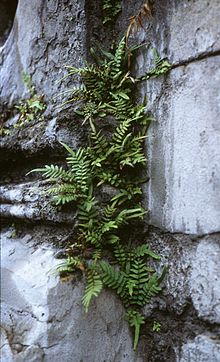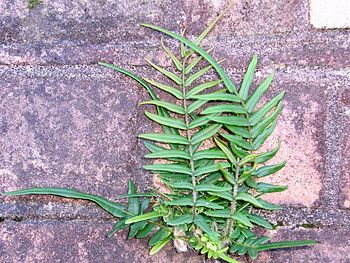- Pteris vittata
-
Pteris vittata 
Scientific classification Kingdom: Plantae Division: Pteridophyta Class: Pteridopsida Order: Pteridales Family: Pteridaceae Genus: Pteris Species: P. vittata Binomial name Pteris vittata
L. [1]Synonyms[2] Pteris vittata, commonly known variously as the Chinese brake,[3] Chinese ladder brake,[3] or simply ladder brake,[3] is a species of fern in the genus Pteris. It is indigenous to Asia, tropical Africa and Australia.[3] The type specimen was collected in China by Pehr Osbeck.[1]
Contents
Habitat and distribution
Pteris vittata is often associated with limestone habitats. It may be seen growing on concrete structures and cracks, in buildings in the central business district and suburbs of Sydney, Australia.[4][5]
Pteris vittata is native and wide spread in the paleotropics: found from the east, to the south tropical, and southern Africa (in Angola; Kenya; Lesotho; Malawi; Mozambique; Namibia; Tanzania (including the Zanzibar Archipelago); Cape Province, Free State, KwaZulu-Natal, and Transvaal in South Africa; Swaziland; Uganda; Zambia; and Zimbabwe); temperate and tropical Asia (in the provinces of Anhui, Gansu, Guangdong, Guangxi, Guizhou, Hubei, Jiangxi, Sichuan, Xizang, and Yunnan in China; the prefectures of Honshu, Kyushu, Shikoku, and the Ryukyu Islands of Japan; and Thailand); and Australia, in the states of New South Wales,[4] Queensland, Victoria, and Western Australia.[3]
It is an introduced species in California, Texas, and the Southeastern United States. [6]
Uses
Although it grows readily in the wild, Pteris vittata is sometimes cultivated.[3] It is grown in gardens for its attractive appearance,[3] or used in pollution control schemes:[3] it is known to be a hyperaccumulator plant of arsenic used in phytoremediation. [7]
Suggested reading
- Cong Tu and Lena Q. Ma ; Effects of Arsenic Concentrations and Forms on Arsenic Uptake by the Hyperaccumulator Ladder Brake, Journal of Environmental Quality doi: 10.2134/jeq2002.6410Vol. 31 No. 2, p. 641-647 (résumé)
References
- ^ a b Pteris vittata was originally described and published in Species Plantarum 2: 1074. 1753. "Name - Pteris vittata L.". Tropicos. Saint Louis, Missouri: Missouri Botanical Garden. http://www.tropicos.org/Name/26602473. Retrieved November 3, 2011.
- ^ "Name - Pteris vittata L. synonyms". Tropicos. Saint Louis, Missouri: Missouri Botanical Garden. http://www.tropicos.org/Name/26602473?tab=synonyms. Retrieved November 3, 2011.
- ^ a b c d e f g h GRIN (July 18, 2007). "Genus epithet information from NPGS/GRIN". Taxonomy for Plants. National Germplasm Resources Laboratory, Beltsville, Maryland: USDA, ARS, National Genetic Resources Program. http://www.ars-grin.gov/cgi-bin/npgs/html/taxon.pl?401988. Retrieved November 3, 2011.
- ^ a b "Pteris vittata, PlantNET - NSW Flora Online, Retrieved June 23, 2011". http://plantnet.rbgsyd.nsw.gov.au/cgi-bin/NSWfl.pl?page=nswfl&lvl=sp&name=Pteris~vittata.
- ^ Les Robinson - Field Guide to the Native Plants of Sydney, ISBN 9780731812110 page 318
- ^ http://plants.usda.gov/java/profile?symbol=PTVI . accessed 9/19/2010
- ^ Wilkins, Carolyn, and Salter, Leo. (2003). Arsenic hyperaccumulation in ferns: A review. Environmental Chemistry Group Bulletin of the Royal Society of Chemistry. July 2003 edition.
 Ladder Brake Fern growing on a brick wall Chatswood, Australia
Ladder Brake Fern growing on a brick wall Chatswood, Australia
External links
 Media related to Pteris vittata at Wikimedia CommonsCategories:
Media related to Pteris vittata at Wikimedia CommonsCategories:- Pteris
- Plants described in 1753
- Fern species
- Flora of Africa
- Flora of Asia
- Flora of Angola
- Flora of Australia
- Flora of New South Wales
- Flora of Queensland
- Flora of Victoria (Australia)
- Flora of Western Australia
- Flora of China
- Flora of Japan
- Flora of the Ryukyu Islands
- Flora of Kenya
- Flora of Lesotho
- Flora of Malawi
- Flora of Mozambique
- Flora of Namibia
- Flora of South Africa
- Flora of Swaziland
- Flora of Tanzania
- Flora of the Zanzibar Archipelago
- Flora of Thailand
- Flora of Uganda
- Flora of Zambia
- Flora of Zimbabwe
- Invasive species
- Phytoremediation plants
- Fern stubs
Wikimedia Foundation. 2010.
